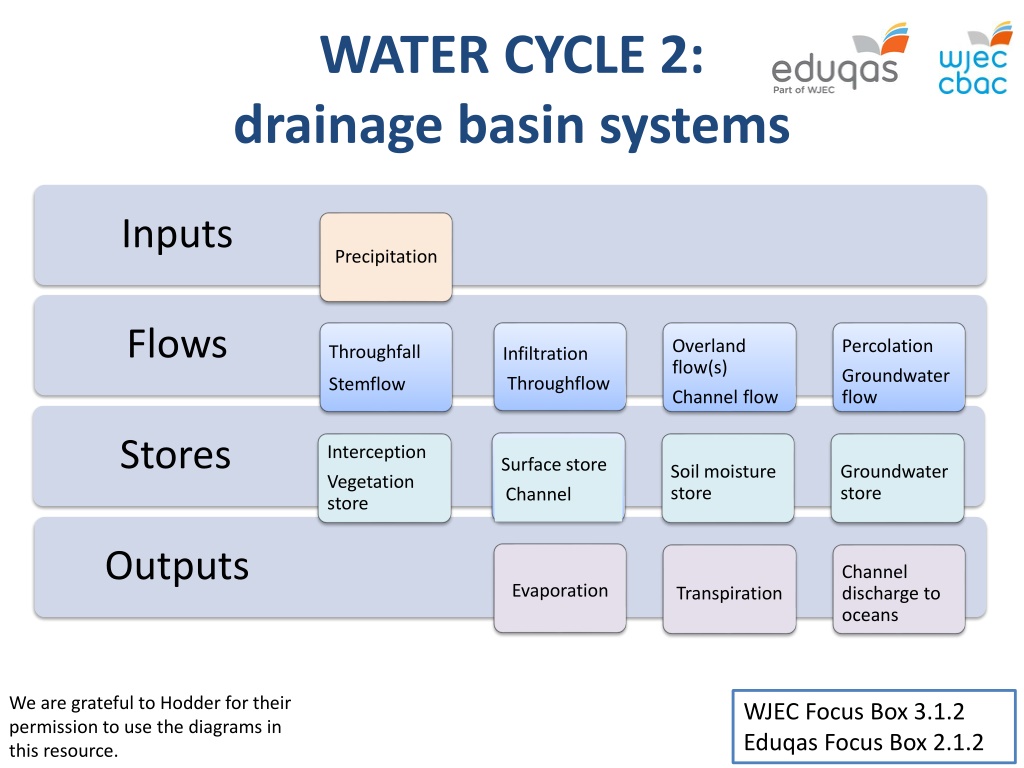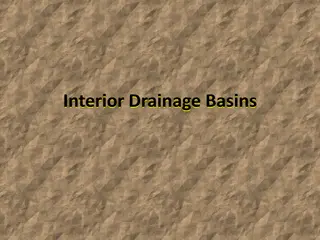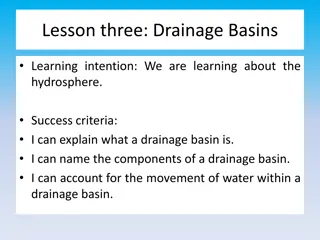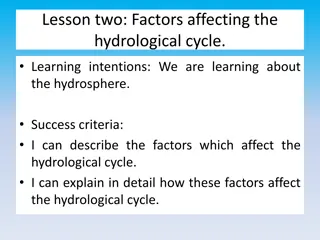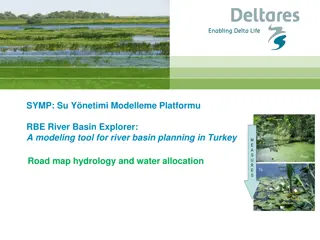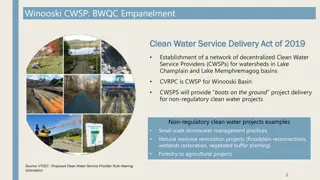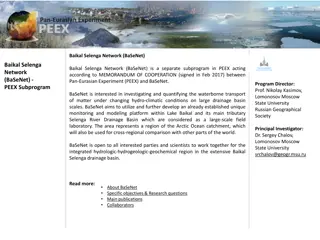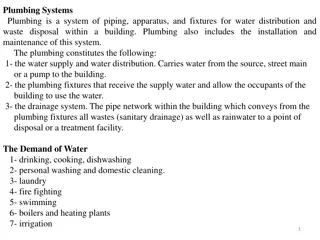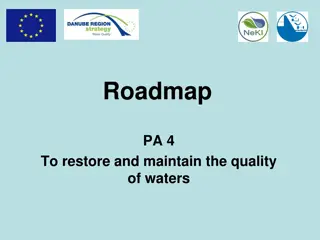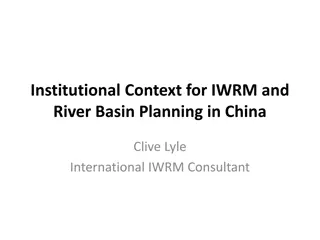Understanding the Water Cycle in Drainage Basin Systems
Explore the dynamics of water flow in drainage basin systems, including inputs such as precipitation, various flows within the system, and outputs like channel discharge and evaporation. Learn about the open nature of river drainage basins, the impact of precipitation variations on system responses, and the processes behind phenomena like flash flooding. Delve into the interconnected components of the water cycle to grasp its significance in environmental systems.
Download Presentation

Please find below an Image/Link to download the presentation.
The content on the website is provided AS IS for your information and personal use only. It may not be sold, licensed, or shared on other websites without obtaining consent from the author. Download presentation by click this link. If you encounter any issues during the download, it is possible that the publisher has removed the file from their server.
E N D
Presentation Transcript
WATER CYCLE 2: drainage basin systems Inputs Precipitation Flows Overland flow(s) Channel flow Percolation Groundwater flow Throughfall Infiltration Throughflow Stemflow Stores Interception Vegetation store Surface store Channel Soil moisture store Groundwater store Outputs Channel discharge to oceans Evaporation Transpiration We are grateful to Hodder for their permission to use the diagrams in this resource. WJEC Focus Box 3.1.2 Eduqas Focus Box 2.1.2
Water Cycle 2 The drainage basin system The drainage basin is a subset of the global hydrological cycle It is defined as a catchment area forming part of the Earth's surface area which is drained by a particular stream or river It is an open system which allows energy and matter to be transferred across its boundary (the watershed or drainage divide) from external areas Class activity Why is a river drainage basin an open system, whereas the global water cycle isa closed system?
Water Cycle 2 Drainage basin inputs There is only one physical input into a drainage basin: precipitation Precipitation types are varied: they includes rain, snow, sleet hail and frost Class activity Why do drainage basin inputs vary from place to place or from time to time? (c) Hodder Education [Edexcel A-level Geography Book 2 (Dunn)]
Water Cycle 2 Precipitation variations The duration and intensity of precipitation both affect how a drainage basin system responds Very high-intensity rainfall of 50-100 millimetres per hour is rare; it can result in flash flooding In Boscastle, 185mm rainfall fell in just five hours in 2004 (equivalent to two months of normal rainfall) Low intensity but relatively long duration rainfall is far more common in the UK Class activity What processes could explain the link between high- intensity rainfall and flash flooding?
Water Cycle 2 Drainage basin flows (1) Class activity How many water flows are shown in this diagram? (c) Hodder Education [Edexcel A-level Geography Book 2 (Dunn)]
Water Cycle 2 Drainage basin flows (2) Rainwater dripping from leaves and branches towards the ground is called throughfall Water which flows to the ground via vegetation stems and trunks is stemflow Infiltration is the movement of water from the ground surface into the soil Throughflow is the movement of water laterally (sideways) through the soil, via (1) a matrix of pore spaces, fissures and (2) pipes (animal burrows) Class activity Why might drainage basin water flows vary from place to place or from time to time?
Water Cycle 2 Drainage basin flows (3) Percolation is the transfer of water from the soil into the underlying bedrock Groundwater flow is the vertical and lateral movement of water through a drainage basin s underlying rock due to gravity and pressure Coarse-grained sedimentary rocks show high permeability and permit high groundwater flow; fine-grained igneous rocks are relatively impermeable Class activity What are the implications of the varying geology of different drainage basins for river flow in dry seasons?
Water Cycle 2 Overland flow(s) Overland flow is the movement of a sheet of water across the ground Infiltration-excess overland flow occurs when rainfall intensity is so great that not all water can infiltrate, irrespective of how dry or wet the soil is Saturation-excess overland flow happens if rainfall continues for a long time. The entire soil becomes saturated; overland flow begins (c) Hodder Education (Geography Review)
Water Cycle 2 Overland flow(s) Class activity Why would different types of overland flow result in differing lag times shown on storm hydrographs? (c) Hodder Education (Geography Review)
Water Cycle 2 Drainage basin stores 1. interception store - leaf and plant surfaces 2. vegetation store - water held in the biomass itself 3. surface store - water collected on the ground in depressions and hollows, and also snow cover 4. soil moisture store - water held in soil pores space 5. channel store - water held in the river channel itself 6. groundwater store - water stored in solid rock and in any superficial deposits e.g. gravels below the soil Class activity Why might drainage basin water storage vary from place to place or from time to time?
Water Cycle 2 Drainage basin stores and limits Class activity Describe and explain the changes in water storage and flows during the storm shown in the diagram (c) Hodder Education [Edexcel A-level Geography Book 2 (Dunn)]
Water Cycle 2 Drainage basin outputs Channel discharge is the water leaving a drainage basin via its main river during a unit of time Evaporation is the change in state of water from a liquid to a gas. Meteorological factors influence the rate of evaporation (temperature and wind speed) Transpiration is the diffusion of water from vegetation into the atmosphere. Water vapour is lost through the stomata (pores) of leaves Class activity Why might drainage basin water outputs vary from place to place or from time to time?
Water Cycle 2 Drainage basin outputs Precipitation (mm) and river flow (mm equivalent) for a river in Scotland Precipitation sometimes falls as snow in Winter It can be stored on the ground for days or months before melting This delays the loss of water from the drainage basin 180 160 140 120 100 80 60 40 20 0 J F M A M J J A S O N D Class activity Describe and explain the variations in precipitation (blue) and river discharge (red) shown in the diagram
Water Cycle 2 Plenary Precipitation varies according to type, amount, duration and intensity Flows include different types of overland flow, in addition to stemflow, throughflow, percolation, groundwater flow and other water transfers Interception plays an important role in preventing or allowing rainwater to move to other stores Local variations in soil and rock type play an important role in river catchment hydrology Water leaves the drainage basin as evaporation, transpiration and channel discharge
